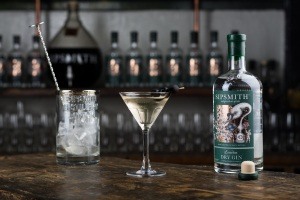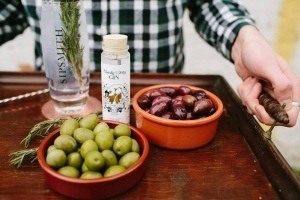An alternative to a lemon twist, bartenders have been popping olives into Martinis for many years. We take a look at the story behind the popular garnish, and how this simple addition gave rise to one of the all-time greatest gin cocktails: the Dirty Martini.
THE HISTORY OF OLIVES IN MARTINIS
Shaken, stirred, dirty, dry – learning how to make the perfect Martini means familiarising yourself with essential Martini terminology. And that includes learning about the ingredients that have garnished the unmistakable silhouette of the Martini glass.
But what if we told you that olives in Martinis haven’t always gone together? When the Martini rose to fame in the 19th century it wasn’t garnished with olives or lemon twists, but cherries. “In the 1860s and 1870s, drinks were sweetened with syrups and piled high with fruit garnishes, and cherries were a particularly popular choice,” says drinks historian and our Master Distiller Jared Brown.
If that sounds slightly unbelievable, keep in mind that early iterations of the Martini were served much wetter (50:50 gin to vermouth ratios were common) than they are today and frequently made with orange bitters.
However, a new trend for savoury garnishes emerged in the 1880s, and bartenders were quick to embrace the olive. Why? Because the flavour highlights the aromatics in the gin, as well as complementing the vermouth and balancing the Martini’s bracing intensity.
ADD BRINE AND THE DIRTY MARTINI IS BORN
Fast-forward to the 1930s, when another pivotal moment in Martini-making occurred between two of the drink’s staunchest admirers. “President Franklin Delano Roosevelt played host to Winston Churchill and introduced him to the Dirty Martini, adding not just olives but a few barspoons of olive brine to the shaker,” says Jared.
“FDR was known to shake his Martinis, and Churchill commented that he was an enthusiastic but sloppy mixer.” We don’t know what Churchill, who famously preferred his Martinis with little to no vermouth, thought about FDR’s beloved brine, but the Dirty Martini has continued to turn heads and tantalise taste buds ever since.
Purists turn up their noses at the thought of adding piquant brine, while enthusiasts adore its savoury, saline attributes. We’ll let you decide as you master the art of making the perfect Dirty Martini.

MASTER THE DIRTY MARTINI
Adding a pleasingly savoury character to the classic Martini, the term ‘dirty’ means that olive brine (usually from a jar of cocktail olives) has been added into the equation. An olive garnish is typically assumed, too. Most bars use equal parts vermouth and brine, though you can specify ‘extra dirty’ or ‘filthy’ if you prefer more brine.
Remember, just a small measure – perhaps using our elegant Swan barspoon – of olive brine is all it takes to transform the traditional Martini into an entirely different classic cocktail.
- 50ml Sipsmith London Dry Gin
- 10-15ml dry vermouth
- 2 barspoons olive brine
- A couple of olives
Combine the gin, dry vermouth and olive brine in an ice-filled mixing glass. Stir then strain into a chilled cocktail glass and garnish with a few olives.
EMBARK ON OLIVE EXPLORATIONS
While Jared says it’s best to avoid pimento-stuffed olives, as the sweetness of the peppers doesn’t necessarily mingle well in a Martini, it’s definitely worth experimenting with your Martini olives.
“Unstuffed, anchovy-stuffed, blue cheese-stuffed – give them all a go and see what you prefer.” You could also follow in the illustrious footsteps of the late Sasha Petraske, who helped inspire the neo-speakeasy movement when he opened Milk & Honey in New York, and who favoured unpitted Cerignola olives from Puglia for their juiciness and soft flavour.

Whichever olives you select, Jared says it’s essential you store them in the fridge. After all, you don’t want an ice-cold Martini warmed up by a room temperature garnish.
Delighted with your Dirty Martini? Experimenting with olive garnishes? We always love to see your cocktail creations, so tag us on social media @sipsmith.
